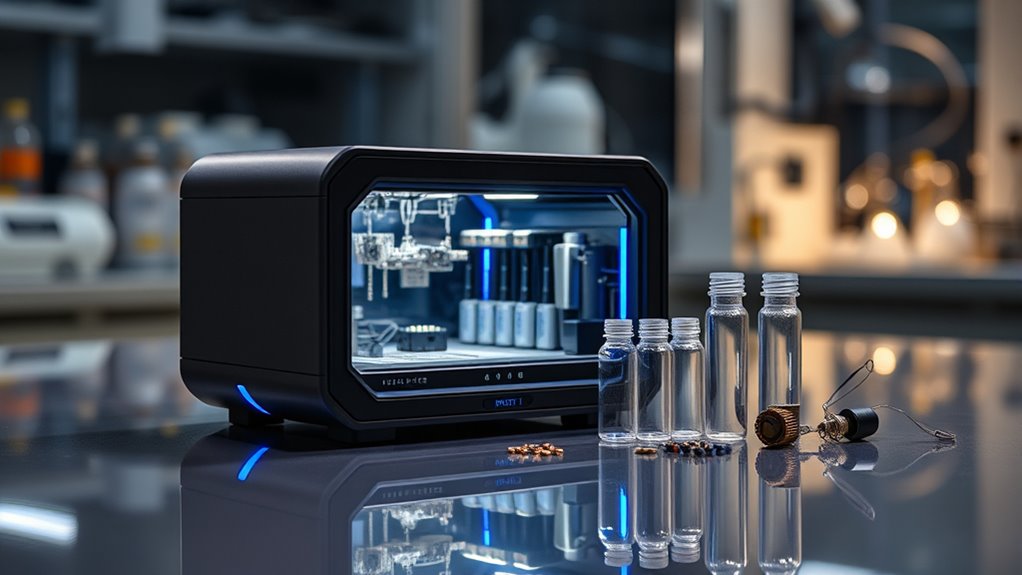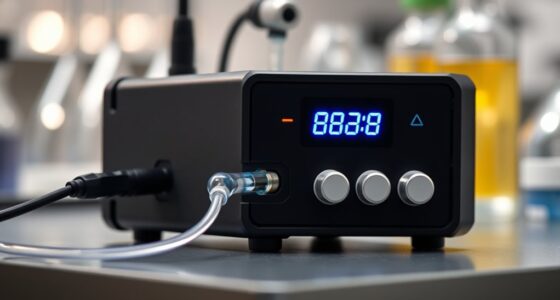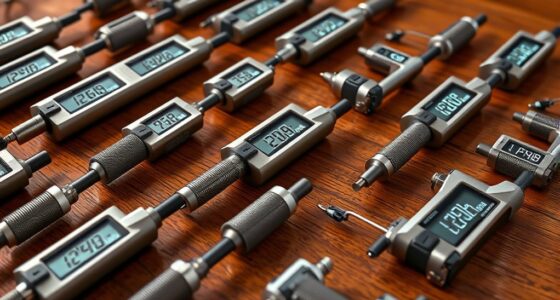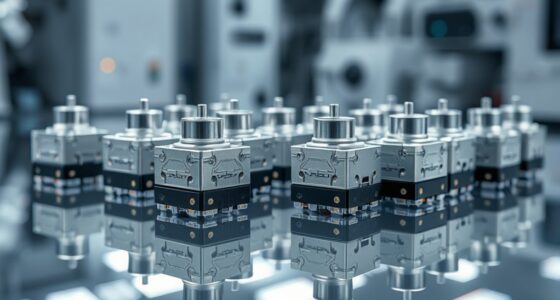The top nanofabrication kit for researchers in 2025 combines exceptional precision, broad material compatibility, and user-friendly features, making it ideal for both small-scale experiments and industrial scaling. It offers nanoscale resolution under stable environmental conditions, with clear instructions and automation options that simplify complex tasks. Cost-wise, it balances affordability with advanced performance, backed by strong support and scalability potential. Keep exploring to discover which kit could revolutionize your nanofabrication projects.
Key Takeaways
- The top nanofabrication kit in 2025 offers unparalleled precision below 10 nm with user-friendly automation and safety features.
- It supports diverse materials like silicon, glass, polymers, ensuring compatibility and minimal substrate damage.
- Designed for scalability, it seamlessly transitions from lab-scale research to industrial manufacturing, validated by successful pilot projects.
- Cost options range from budget-friendly to premium systems, with comprehensive support, tutorials, and ongoing updates.
- Its proven reliability accelerates research-to-commercialization, reducing redesign needs and maintaining a competitive edge.
Fiberglass Cloth Plain Weave for Boat and Auto Repair

If you’re looking for a reliable material for boat and auto repairs, fiberglass cloth with a plain weave is an excellent choice. Made from alkali-free glass fiber, it’s only about 0.05 mm thick, yet incredibly strong and flexible. Its smooth, flaw-free surface makes application straightforward, and it offers excellent heat, corrosion, and flame resistance. This lightweight cloth works well on various surfaces like metal, plastic, and wood, making it versatile for marine, automotive, and DIY projects. Packaged to prevent creases, it’s easy to cut and apply with resin, resulting in durable, waterproof repairs that stand the test of time.
Best For: DIY enthusiasts, boat owners, and auto repair professionals seeking a versatile, durable fiberglass cloth for waterproof and flame-resistant repairs on various surfaces.
Pros:
- Strong and flexible with a smooth, flaw-free surface for easy application
- Heat, corrosion, and flame resistant, ensuring long-lasting repairs
- Lightweight and easy to cut, compatible with resin for waterproof, durable results
Cons:
- Requires proper handling and resin application for optimal strength
- Thickness of approximately 0.03 mm may limit certain heavy-duty repair uses
- Packaging can be prone to creases if not stored carefully
Factors to Consider When Choosing a Nanofabrication Kit for Researchers

When selecting a nanofabrication kit, I focus on compatibility with the materials I work with and the level of precision it offers. Ease of use, safety features, and staying within budget are also critical factors that influence my decision. Considering these points helps guarantee I choose a kit that meets my research needs effectively.
Compatibility With Materials
Have you considered how well a nanofabrication kit aligns with the materials you plan to work with? It’s essential to ensure the kit supports your target substrates, whether silicon, glass, polymers, or composites. Check that the processing techniques—deposition, etching, lithography—are compatible with your materials and won’t alter their properties adversely. For example, some chemical or thermal processes might damage sensitive substrates or change their characteristics. Additionally, verify that the kit can achieve the feature resolution you need, especially at the nanoscale level. Safety protocols are also critical—handling materials safely is non-negotiable. Overall, compatibility isn’t just about processing; it’s about guaranteeing your chosen kit can work seamlessly with your materials without compromising their integrity or your safety.
Precision and Resolution
Choosing a nanofabrication kit involves considering the level of detail you need to achieve. Higher precision kits can produce features smaller than 10 nanometers, which is pivotal for advanced research. Resolution determines the smallest reliably patterned feature size, directly affecting device performance and accuracy. The fabrication method, such as electron beam lithography or nanoimprint, impacts both resolution and pattern fidelity. To maintain consistent resolution, stable environmental conditions are essential—vibration isolation, temperature control, and damping help prevent distortions. Keep in mind that resolution limits are influenced by equipment calibration, material properties, and resist or mask quality. Selecting a kit with the right combination of precision and resolution capabilities ensures your research results are accurate, reliable, and meet the demanding standards of nanotechnology.
Ease of Use
Selecting a nanofabrication kit that’s easy to use can considerably streamline your research process. A user-friendly kit should provide clear, thorough instructions, guiding you through each step without confusion. Pre-measured components and easily accessible parts help minimize setup time and reduce complexity, letting you focus on your experiments. Features like intuitive interfaces or automation simplify intricate tasks such as patterning or etching, making advanced techniques more approachable. Compatibility with standard lab equipment and minimal need for specialized tools also boost ease of use, saving you from unnecessary hassles. Additionally, robust safety features and straightforward troubleshooting guides ensure you can address issues quickly, regardless of your experience level. Overall, simplicity in design and operation enhances productivity and confidence in your nanofabrication endeavors.
Cost and Budget
When evaluating nanofabrication kits, cost plays a fundamental role in determining whether a system fits within your research budget. Prices vary widely, with budget options under $1,000 and advanced systems exceeding $100,000. It’s essential to consider not just the initial purchase but also ongoing expenses like maintenance, consumables, and potential upgrades. More complex systems often require additional training and support, which can add to the overall cost. Budget constraints may limit certain features or capabilities, so balancing desired functionality with affordability is critical. To make an informed decision, I recommend calculating the cost per experiment or process, helping you assess the long-term value and feasibility of your investment. This approach guarantees your nanofabrication kit aligns with both your research needs and financial capacity.
Safety Features
Safety features are a vital consideration alongside cost because nanofabrication involves handling potentially hazardous materials and equipment. I look for kits with chemical-resistant surfaces and proper ventilation to protect against exposure. Personal protective equipment like gloves, masks, and eye protection are essential to minimize risks. Safety interlocks and automatic shut-off mechanisms help prevent accidents caused by equipment malfunction or misuse. Proper waste containment and disposal systems are essential to avoid environmental contamination and researcher exposure. Clear safety instructions and hazard labels on packaging ensure proper handling and raise awareness of potential risks. These features not only safeguard health but also promote responsible research practices. Prioritizing safety ensures that nanofabrication remains a controlled and secure process for everyone involved.
Support and Resources
Have you considered how essential accessible support and resources are for making the most of a nanofabrication kit? Reliable technical support and troubleshooting resources are critical, especially when tackling complex fabrication tasks. Complete documentation, like user manuals and step-by-step guides, can accelerate your learning curve and reduce frustration. Online tutorials, webinars, and community forums foster knowledge sharing and problem-solving, keeping you engaged and informed. Responsive customer service and expert consultation are invaluable for addressing challenging issues and maximizing kit performance. Additionally, access to updates, firmware, and supplementary materials ensures your equipment stays compatible with the latest research techniques. Prioritizing these support features helps you stay efficient, troubleshoot effectively, and continually enhance your nanofabrication skills.
Scalability Potential
Choosing a nanofabrication kit with strong scalability potential is essential for researchers aiming to shift from lab experiments to larger-scale production. I look for kits that support scaling up processes without sacrificing quality, ensuring compatibility with larger batch sizes and higher throughput needs. Flexibility is key—modular components or adjustable parameters make gradual expansion smoother and more manageable. I also evaluate whether the kit can handle increased substrate sizes efficiently. Proven performance in pilot projects or previous scaled-up applications demonstrates reliability and confidence in the kit’s capabilities. Ultimately, a scalable nanofabrication kit should seamlessly transition from small experiments to industrial-level production, helping to accelerate research and enable commercialization without costly redesigns or process overhauls.
Frequently Asked Questions
How Does Nanofabrication Kit Compatibility Vary With Different Research Fields?
Nanofabrication kit compatibility really depends on your research field. I’ve found that in electronics, I need precise, high-resolution tools, while in biomedicine, compatibility with biological materials is vital. Different fields demand specific features, like cleanroom standards or material versatility. I always check if the kit supports my materials and processes before investing, ensuring seamless integration with my research goals and avoiding compatibility issues.
What Safety Features Are Essential in a Top-Tier Nanofabrication Kit?
Safety features in a top-tier nanofabrication kit are vital for protecting users and ensuring precise results. I look for integrated fume hoods, automatic shut-off systems, and proper grounding to prevent static buildup. Clear safety instructions, emergency stop buttons, and protective enclosures are essential. These features not only guard against hazards but also promote a safe, efficient workspace, giving me confidence when handling delicate nanomaterials.
Can Nanofabrication Kits Be Customized for Specific Research Needs?
Absolutely, nanofabrication kits can be tailored to specific research needs. I’ve seen customizations like specialized tools, software integrations, and tailored process modules that fit unique project requirements. When I look for a kit, I prioritize flexibility and modular options that allow me to adapt the system as my research evolves. Customizing guarantees I get the precision and capabilities necessary for breakthrough discoveries in my field.
What Are the Maintenance Requirements for Advanced Nanofabrication Tools?
Maintaining advanced nanofabrication tools is like tending a delicate garden; it requires regular care and attention. I keep the equipment clean, calibrated, and perform routine checks to prevent issues. Replacing filters and lubricating moving parts are essential tasks. Additionally, I follow manufacturer guidelines for software updates and environmental controls to guarantee ideal performance. Proper maintenance keeps my tools precise and reliable, minimizing downtime and extending their lifespan.
How Do Cost and Budget Influence Nanofabrication Kit Selection?
Cost and budget play a huge role in my nanofabrication kit choices because they determine what features I can afford. I look for options that balance quality and expense, ensuring I don’t overspend while still getting reliable tools. Sometimes I opt for more affordable kits with essential features, but I also consider long-term benefits and upgrade possibilities to make the most of my investment.
Conclusion
Choosing the right nanofabrication kit is like selecting the perfect compass for uncharted waters—you want precision, reliability, and support to guide your journey. By considering factors like compatibility, ease of use, and safety, you’ll steer confidently toward groundbreaking research. Remember, the right tools can transform your lab into a vessel of discovery, steering the complex currents of innovation with clarity and purpose. Here’s to charting your course in nanotech with confidence.









